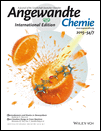Luminescent Pincer Platinum(II) Complexes with Emission Quantum Yields up to Almost Unity: Photophysics, Photoreductive CC Bond Formation, and Materials Applications†
This work was supported by the Hong Kong Research Grants Council (HKU 700812P), the CAS-Croucher Foundation Funding Scheme for Joint Laboratories, the Area of Excellence Program (AoE/P-03/08), the National Key Basic Research Program of China (2013CB834802), and the Guangdong Special Project of the Introduction of Innovative R&D Teams, China. We are thankful for the assistance of The University of Hong Kong Li Ka Shing Faculty of Medicine Faculty Core Facility for use of the laser scan confocal microscope.
Graphical Abstract
Multipurpose platinum: A phosphorescent PtII complex 1 with an emission quantum yield of 0.99 is employed as a catalyst for visible-light-induced reductive CC bond formation and as a dopant in organic light-emitting diodes with an external quantum efficiency of 22.8 %. Encapsulating 1 in mesoporous SiO2 for two-photon-excited cellular imaging has been demonstrated.
Abstract
Luminescent pincer-type PtII complexes supported by C-deprotonated π-extended tridentate RC^N^NR′ ligands and pentafluorophenylacetylide ligands show emission quantum yields up to almost unity. Femtosecond time-resolved fluorescence measurements and time-dependent DFT calculations together reveal the dependence of excited-state structural distortions of [Pt(RC^N^NR′)(CC-C6F5)] on the positional isomers of the tridentate ligand. Pt complexes [Pt(R-C^N^NR′)(CC-Ar)] are efficient photocatalysts for visible-light-induced reductive CC bond formation. The [Pt(R-C^N^NR′)(CC-C6F5)] complexes perform strongly as phosphorescent dopants for green- and red-emitting organic light-emitting diodes (OLEDs) with external quantum efficiency values over 22.1 %. These complexes are also applied in two-photon cellular imaging when incorporated into mesoporous silica nanoparticles (MSNs).





